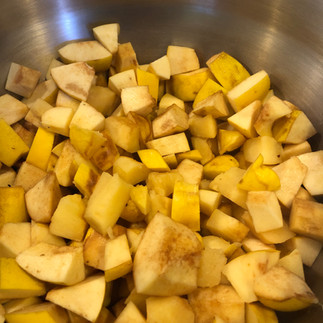Quince Paste: From the Ground Up
- EagleSong Gardener
- Nov 26, 2023
- 4 min read

Quince fruit with quince paste and quince delight
I first met quince, Cydonia oblonga, while the farm manager for The Herbfarm restaurant in Woodinville, WA. There was a small quince tree growing in the orchard that produced hard, yellow, amazingly fragrant fruit. That chance meeting sparked my curiosity and many years later a quince tree was planted at RavenCroft Garden. After the tree was in the ground 3 years, we enjoyed the first harvest of 23 fruits this fall. Grown on dwarf root stalk, quince make a small, compact tree with thick, green, leathery leaves. A good fruit tree for the small holding or garden. I prefer to grow interesting, harder to find fruits in the home garden leaving apples, pears and easier to find fruits for local orchardists to grow.
Quince in a bowl, on the tree and distinctively part of the 5 seed star Rose family of fruits
A plant in the rose family the typical 5 seed star is in the center of each fruit. Quince are rock hard, dry and astringent when picked. Not a fresh eating fruit, cooking is necessary to bring out the delicious, nutrient dense qualities. Luckily this seasonal grace allows time for the many tasks of wrapping up summer and preparing for winter whilst they rest in the pantry.
Thanksgiving weekend arrived and cooking was a main activity. Bustling in the kitchen with family is a part of the holiday I enjoy. After the festive meal and gathering with family was over, I heard the quince calling! What a pleasant way to spend a quiet Saturday making turkey soup and quince paste...membrillo, in Spanish, cotognata in Italian, cotignac in French.
One of many things I enjoy about plants is the green keys to the world they've given me, opening doors in the garden, kitchen and apothecary through time.
Chopped quince, quince on silicone sheet heading to dehydrator, dried quince delight dusted with a mix of powdered sugar and corn starch.
Quince paste...like life, it's more of a process than a recipe!
Begin here...
Quince Paste
First core and chop the hard, dry fruit. No need to peel. Add 1"- 2" water or apple cider to the pan to prevent fruit from burning as it begins cooking. Gently bring quince to a slow boil then turn to medium low heat and cook 2-3 hours. As the paste thickens reduce heat and stir consistently to prevent scorching. (You can stop midway, reheat and begin again later if needs be. This is a regular practice in traditional jam making allowing the fruit to give itself to the process without excessive heating. Once the fruit cooks for a couple hours the anthocyanins are activated and the paste turns a beautiful pink or red color.
At this point, add sugar, zest and lemon juice to taste. Continue cooking to dissolve sugar. Cook until the paste is thick enough to stay in 2 loosely separate parts in the bottom of the pan when a spoon is dragged through the center. Now, you can put the paste into hot jars and seal or continue cooking a bit more...
The fragrance of the quince cooking is a delight for the senses.
Going deeper...
Create a soft, chewy, nutrient dense, concentrated confection...
Place the paste on a silicone sheet and put in a dehydrator or oven set on dehydrate. This process will take a fair amount of time as the quince and sugar are humectants that tend to pull moisture to themselves from the air. Once the fruit paste is chewy-dry, cut it into pieces and dust with a 50/50 mixture of powdered sugar and cornstarch. This mitigates some of the inevitable stickiness. After setting a small bowl out to eat now, I freeze most of the batch to enjoy through winter.
Quince paste may be served as part of a cheese plate. It also makes a delicious accompaniment to meat or savory dishes. Quince Delight is called for when you're inclined to enjoy a bit of delight!
As a young woman I wanted an integrated life living close with nature, homesteading seemed a way to achieve that end. Now, 50 years and several farms and homesteads later, I am delighted to experience RavenCroft Garden entering her 3rd decade and with that passage of time, revel in the changes and transformations we've been through along the way. Sally grew a fruit tree into production and I made something as delicious and wonderful as Membrillo from those fruits. This ground deepens us as human beings in our love of life on earth.
If you're interested in the process of growing closer with earth and yourself, I invite you to check out the in-person apprenticeship offerings at RavenCroft Garden. Live far away? We've got you covered through the HerbWiseWomen online community where you can grow and transform in your place at your own pace.










































Comments